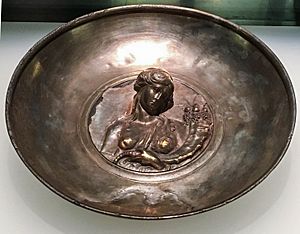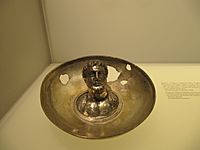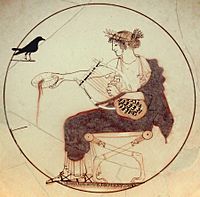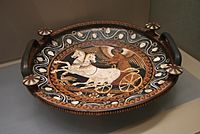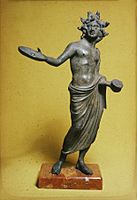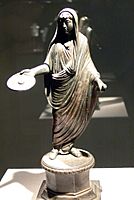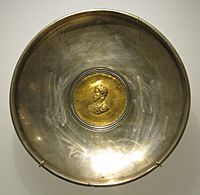Patera facts for kids
A phiale (pronounced fee-AH-lay) or patera (pronounced PAH-teh-rah) was a special kind of shallow bowl used in ancient times. These bowls were often made from pottery or metal. People in ancient Greece and Rome used them for religious ceremonies, especially for pouring out liquids as an offering to their gods. This act was called a libation.
Many phiales had a small bump in the middle of the bottom, like a "bellybutton," which helped people hold them. These bowls usually didn't have handles or feet. While "phiale" was more common in ancient Greece, "patera" was often used in ancient Rome.
What They Were Used For
Pouring out offerings, called libations, was a very important part of ancient Greek religion. It was one of the simplest and most common ways people showed their respect to the gods. This practice goes back to the Bronze Age and even earlier times in Greece.
Libations were part of daily life. People who were very religious might perform them every morning and evening. They also did them before starting meals. An offering usually involved pouring a mix of wine and water. Sometimes, people would offer pure wine, honey, oil, water, or milk instead.
Greek Rituals
The most common way to perform a libation was to pour wine from a special wine jug, called an oinochoē, into a phiale. This pouring ritual was often done while saying a prayer. Greeks would stand when they prayed, sometimes with their arms raised. When performing a libation, they would hold the phiale with their right arm extended. After pouring some of the wine as an offering, the person performing the ritual would drink the rest.
Roman Rituals
In ancient Rome, people are often shown in art pouring libations at an altar, a special table for offerings (called a mensa), or a three-legged stand (a tripod). This was the simplest type of offering and could be enough by itself.
Before sacrificing an animal, Romans would perform an introductory rite. This included pouring incense and wine onto a burning altar. Roman emperors and gods are often shown on coins pouring offerings from a patera. These scenes and the patera itself often represented pietas, which meant religious duty or respect for the gods.
Images for kids
-
Phiale found in eastern Georgia, showing a bearded man. From the Georgian National Museum.
-
Cylix of Apollo, who pours a libation (Attic white-ground kylix, around 460 BC).
-
Patera showing Marcus Aurelius found in Georgia, 2nd century AD.
-
Silver patera from Hispania (Roman Spain), 2nd–1st century BC.
See also
 In Spanish: Pátera para niños
In Spanish: Pátera para niños


